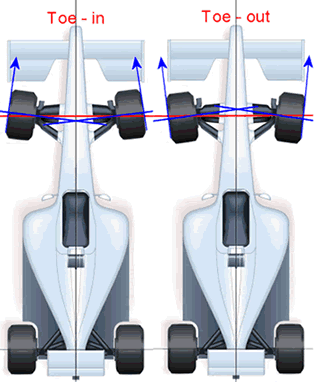Toe

| /--\ = positive toe / Toe In (view from Top of car) \--/ = negative toe / Toe Out (view from Top of car) |
Positive toe on the rear wheels will stop oversteer because the wheels are at this angle /--\ (looking from the top of the car). That's great for corners but reduces acceleration on the exits and straights because there isn't as much tire contact to the ground as a zero toe like this |--| .
So as you can see there is a compromise.
Quick physics lesson. Looking at the diagram above ... when going around a left hand corner the weight of the car leans to the right two tires. The negative front toe makes the car turn sharper left, while the positive toe rear swings the rear further out to the right, making the car point left into the left hand corner.
The compromise of fixing understeering or oversteering using toe adjustments is that tire wear will increase. There is always a compromise in every adjustment, we don't live in a perfect world. Engineers always try to reduce oversteer and understeer using adjustments to springs, shocks, stabilizers and wings first. Only think about toe adjustments as a last resort, since any toe value added will increase tire wear.
The amount of toe can be expressed in degrees as the angle to which the wheels are out of parallel, or more commonly, as the difference between the track widths as measured at the leading and trailing edges of the tires or wheels. Toe settings affect three major areas of performance: tire wear, straight-line stability and corner entry handling characteristics.
For minimum tire wear and power loss, the wheels on a given axle of a car should point directly ahead when the car is running in a straight line. Excessive toe-in or toe-out causes the tires to scrub, since they are always turned relative to the direction of travel. Too much toe-in causes accelerated wear at the outboard edges of the tires, while too much toe-out causes wear at the inboard edges. So if minimum tire wear and power loss are achieved with zero toe, why have any toe angles at all? The answer is that toe settings have a major impact on directional stability.
Positive toe permits both wheels to constantly generate force against one another, which reduces turning ability. However, positive tow creates straighter driving characteristics.
Negative toe is often used in front wheel drive vehicles for the opposite reason. Their suspension arms pull slightly inward, so a slight negative toe will compensate for the drag and level out the wheels at speed. Negative toe increases a cars cornering ability. When the vehicle begins to turn inward towards a corner, the inner wheel will be angled more aggressively. Since its turning radius is smaller than the outer wheel due to the angle, it will pull the car in that direction. Negative toe decreases straight line stability as a result. Any slight change in direction will cause the car to hint towards one direction or the other.
Back to the top of the page






